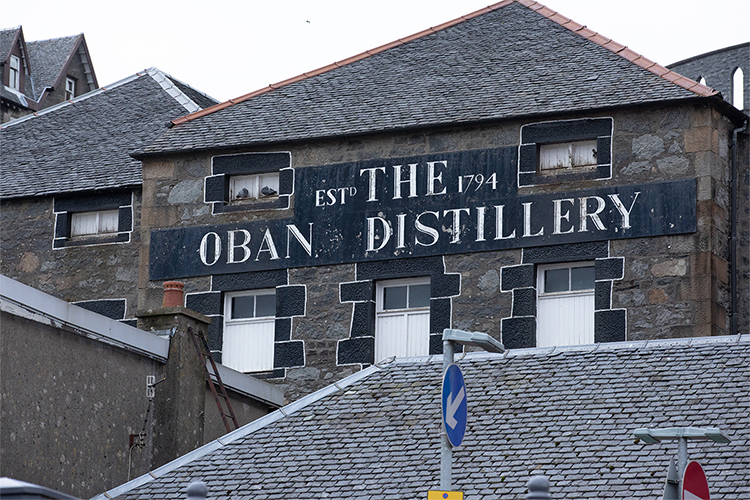Oban’s story
Oban is one of the oldest distilleries in Scotland. It was opened in 1794 and is one of the few remaining that was founded in the 18th century. Oban is also one of the smallest distilleries in Scotland with production of only under one million litres per year. This is due to the restrictions of its location – the distillery is situated in the heart of the town of Oban, on the west Highland coast, and is surrounded on all sides by other buildings, making any expansion impossible.
In the late-1700s Oban was a tiny fishing community. Once the distillery was built, the town literally grew up around it. Despite this, Oban is a popular and well regarded single malt and is especially popular in the USA. This is due, in no small part, to owners Diageo continuing to select Oban to be the west Highlands representative in their ‘Classic Malts’ series.
It can be argued that this has saved Oban from relative obscurity as a single malt. The small production volume dictates that only a small, compact cire range plus occassional limited editions or distillery exclusives can be released. The remainder of the whisky produced there is a highly prized by blenders and is used in several of Diageo’s blended Scotch whiskies.
Oban’s history
The distillery was founded in 179 by brothers John and Hugh Stevenson and initially run as a brewery. In 1798, distillation equipment was installed and whisky production began in earnest. The Stevensons were businessmen with their fingers in many moneymaking pies – this included slate mining, shipping and house building. Oban was one of the first cases of a distillery being set up by office based money men rather than traditional farmers or distillers.
Oban remained in the Stevenson family until 1866, when local man Peter Cumstie saved the distillery from bankruptcy. He later sold in 1883 to another local, Walter Higgins – he modernised the distillery before selling on to a consortium consisting of John Dewar & Sons, James Buchanan & Co and White Horse Distillers in 1898. Despite its relatively remote location, Oban continued to thrive while other similar distilleries failed. This was aided by the construction of the Crinan canal and the railway in the 1880s, which helped link Oban to other major industrial centres such as Glasgow and Edinburgh.
In 1925, this consortium became part of Distillers Company Limited (DCL), which later evolved into United Distillers and finally Diageo. Two periods of closure followed – the first between 1931 and 1937 due to the world wide whisky slump following Prohibition in the USA and the second between 1968 and 1972 when a new stillroom was constructed. Oban is currently Diageo’s third smallest distillery, behind only Royal Lochnagar in the eastern Highlands and Port Ellen on Islay.
- How to pronounce Oban? oh-ban
- Country: Scotland
- Region: Highlands
- Founded: 1794
- Current owners: Diageo
- Production capacity per year: 870,000 litres
- Mash tun: 7 ton stainless steel
- Washbacks: 4
- Stills: 2
- Visitor centre: Yes
Oban Distillery
Stafford Street
Oban
PA34 5NH
tel – +44(0)1631 572004
www.obanwhisky.com
www.malts.com/oban
Did you know?
McCaig’s Tower is Oban’s most famous landmark. It was built by local banker, John Stuart McCaig, who studied Roman architecture. He convinced the town council to build a replica of the Colosseum in Rome on the hillside above the town in 1897. Unfortunately, McCaig died in 1902 and his money ran out, so it has never been completed. It is therefore known as McCaig’s Folly.
Oban





